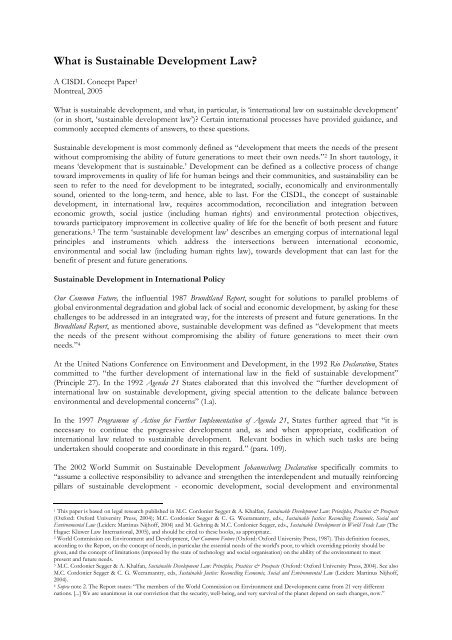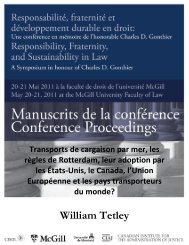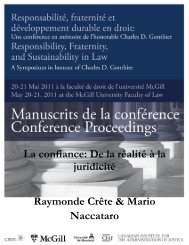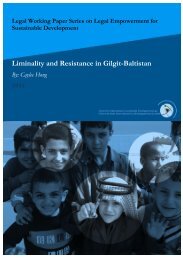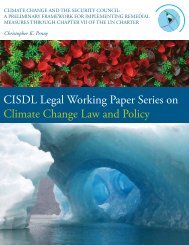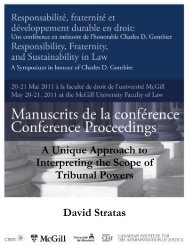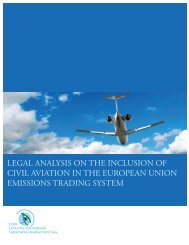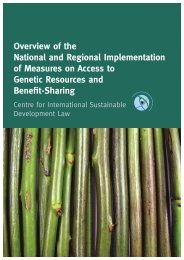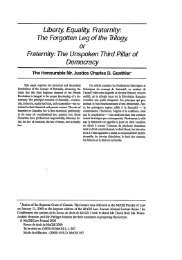What is Sustainable Development Law? - CISDL
What is Sustainable Development Law? - CISDL
What is Sustainable Development Law? - CISDL
You also want an ePaper? Increase the reach of your titles
YUMPU automatically turns print PDFs into web optimized ePapers that Google loves.
<strong>What</strong> <strong>is</strong> <strong>Sustainable</strong> <strong>Development</strong> <strong>Law</strong><br />
A <strong>CISDL</strong> Concept Paper 1<br />
Montreal, 2005<br />
<strong>What</strong> <strong>is</strong> sustainable development, and what, in particular, <strong>is</strong> ‘international law on sustainable development’<br />
(or in short, ‘sustainable development law’) Certain international processes have provided guidance, and<br />
commonly accepted elements of answers, to these questions.<br />
<strong>Sustainable</strong> development <strong>is</strong> most commonly defined as “development that meets the needs of the present<br />
without comprom<strong>is</strong>ing the ability of future generations to meet their own needs.” 2 In short tautology, it<br />
means ‘development that <strong>is</strong> sustainable.’ <strong>Development</strong> can be defined as a collective process of change<br />
toward improvements in quality of life for human beings and their communities, and sustainability can be<br />
seen to refer to the need for development to be integrated, socially, economically and environmentally<br />
sound, oriented to the long-term, and hence, able to last. For the <strong>CISDL</strong>, the concept of sustainable<br />
development, in international law, requires accommodation, reconciliation and integration between<br />
economic growth, social justice (including human rights) and environmental protection objectives,<br />
towards participatory improvement in collective quality of life for the benefit of both present and future<br />
generations. 3 The term ‘sustainable development law’ describes an emerging corpus of international legal<br />
principles and instruments which address the intersections between international economic,<br />
environmental and social law (including human rights law), towards development that can last for the<br />
benefit of present and future generations.<br />
<strong>Sustainable</strong> <strong>Development</strong> in International Policy<br />
Our Common Future, the influential 1987 Brundtland Report, sought for solutions to parallel problems of<br />
global environmental degradation and global lack of social and economic development, by asking for these<br />
challenges to be addressed in an integrated way, for the interests of present and future generations. In the<br />
Brundtland Report, as mentioned above, sustainable development was defined as “development that meets<br />
the needs of the present without comprom<strong>is</strong>ing the ability of future generations to meet their own<br />
needs.” 4<br />
At the United Nations Conference on Environment and <strong>Development</strong>, in the 1992 Rio Declaration, States<br />
committed to “the further development of international law in the field of sustainable development”<br />
(Principle 27). In the 1992 Agenda 21 States elaborated that th<strong>is</strong> involved the “further development of<br />
international law on sustainable development, giving special attention to the delicate balance between<br />
environmental and developmental concerns” (1.a).<br />
In the 1997 Programme of Action for Further Implementation of Agenda 21, States further agreed that “it <strong>is</strong><br />
necessary to continue the progressive development and, as and when appropriate, codification of<br />
international law related to sustainable development. Relevant bodies in which such tasks are being<br />
undertaken should cooperate and coordinate in th<strong>is</strong> regard.” (para. 109).<br />
The 2002 World Summit on <strong>Sustainable</strong> <strong>Development</strong> Johannesburg Declaration specifically commits to<br />
“assume a collective responsibility to advance and strengthen the interdependent and mutually reinforcing<br />
pillars of sustainable development - economic development, social development and environmental<br />
1<br />
Th<strong>is</strong> paper <strong>is</strong> based on legal research publ<strong>is</strong>hed in M.C. Cordonier Segger & A. Khalfan, <strong>Sustainable</strong> <strong>Development</strong> <strong>Law</strong>: Principles, Practices & Prospects<br />
(Oxford: Oxford University Press, 2004); M.C. Cordonier Segger & C. G. Weeramantry, eds., <strong>Sustainable</strong> Justice: Reconciling Economic, Social and<br />
Environmental <strong>Law</strong> (Leiden: Martinus Nijhoff, 2004) and M. Gehring & M.C. Cordonier Segger, eds., <strong>Sustainable</strong> <strong>Development</strong> in World Trade <strong>Law</strong> (The<br />
Hague: Kluwer <strong>Law</strong> International, 2005), and should be cited to these books, as appropriate.<br />
2<br />
World Comm<strong>is</strong>sion on Environment and <strong>Development</strong>, Our Common Future (Oxford: Oxford University Press, 1987). Th<strong>is</strong> definition focuses,<br />
according to the Report, on the concept of needs, in particular the essential needs of the world's poor, to which overriding priority should be<br />
given, and the concept of limitations (imposed by the state of technology and social organ<strong>is</strong>ation) on the ability of the environment to meet<br />
present and future needs.<br />
3 M.C. Cordonier Segger & A. Khalfan, <strong>Sustainable</strong> <strong>Development</strong> <strong>Law</strong>: Principles, Practices & Prospects (Oxford: Oxford University Press, 2004). See also<br />
M.C. Cordonier Segger & C. G. Weeramantry, eds, <strong>Sustainable</strong> Justice: Reconciling Economic, Social and Environmental <strong>Law</strong> (Leiden: Martinus Nijhoff,<br />
2004).<br />
4<br />
Supra note 2. The Report states: “The members of the World Comm<strong>is</strong>sion on Environment and <strong>Development</strong> came from 21 very different<br />
nations. [...] We are unanimous in our conviction that the security, well-being, and very survival of the planet depend on such changes, now.”
protection - at the local, national, regional and global levels” (para. 5). The Johannesburg Plan of<br />
Implementation mandated the UN Comm<strong>is</strong>sion on <strong>Sustainable</strong> <strong>Development</strong> to “(e) Take into account<br />
significant legal developments in the field of sustainable development, with due regard to the role of<br />
relevant intergovernmental bodies in promoting the implementation of Agenda 21 relating to international<br />
legal instruments and mechan<strong>is</strong>ms.” (para 148 at e)<br />
<strong>Sustainable</strong> <strong>Development</strong> in International <strong>Law</strong><br />
In international law, the concept of sustainable development has gained some definition over the course<br />
of the past two decades. It <strong>is</strong> not clear that sustainable development has, as yet, the character of a<br />
customary norm of international law. 5 But neither <strong>is</strong> it void of all meaning or normative value in<br />
international law. Rather, it can be argued that the concept of sustainable development has a dual nature in<br />
international law. It can be considered an interstitial norm, which serves to reconcile other conflicting<br />
norms related to the environment, the economy and social development (including human rights), 6 and<br />
also simply the object and purpose of many international treaties and legal instruments.<br />
In the recent dec<strong>is</strong>ions of international courts and tribunals, the concept of sustainable development<br />
facilitates the reconciliation and integration of other norms concerning socio-economic development and<br />
protection of the environment. It appears to have played such a role in Gabcikovo – Nagymaros Case at the<br />
International Court of Justice:<br />
“Throughout the ages, mankind has, for economic and other reasons, constantly interfered with<br />
nature. In the past, th<strong>is</strong> was often done without consideration of the effects upon the<br />
environment. Owing to new scientific insights and to a growing awareness of the r<strong>is</strong>ks for<br />
mankind - for present and future generations of pursuit of such interventions at an unconsidered<br />
and unabated pace, new norms and standards have been developed, set forth in a great number of<br />
instruments during the last two decades. Such new norms have to be taken into consideration,<br />
and such new standards given proper weight, not only when States contemplate new activities but<br />
also when continuing with activities begun in the past. Th<strong>is</strong> need to reconcile economic development with<br />
protection of the environment <strong>is</strong> aptly expressed in the concept of sustainable development.” 7 (Emphas<strong>is</strong> added).<br />
The Permanent Court of Arbitration reaffirmed th<strong>is</strong> reasoning in its Arbitral Award for the Arbitration<br />
Regarding the Iron Rhine ("Ijzeren Rijn") Railway (Belgium v. Netherlands) (May 24, 2005). In th<strong>is</strong> case, The<br />
Netherlands, which had created nature reserves along the path of the h<strong>is</strong>toric ‘Iron Rhine’ railway line,<br />
sought to prevent its reactivation. Belgium argued that the upgrading of the Iron Rhine Railway was part<br />
of a shift from road to rail transportation, ass<strong>is</strong>ting in the reduction of greenhouse gases, in order to<br />
contribute to sustainable development. The Tribunal balanced environmental protection against socioeconomic<br />
development, finding that the application of environmental measures by the Netherlands could<br />
not amount to a denial of Belgium’s transit right, nor could these measures render the exerc<strong>is</strong>e of such a<br />
right unreasonably difficult. In its reasoning, the Tribunal refers to the “notion[ ]… of sustainable<br />
development”, and at para. 59, states that:<br />
“[e]nvironmental law and the law on development stand not as alternatives but as mutually<br />
reinforcing, integral concepts, which require that where development may cause significant harm<br />
to the environment, there <strong>is</strong> a duty to prevent, or at least mitigate such harm. ... Th<strong>is</strong> duty, in the<br />
opinion of the Tribunal, has now become a principle of general international law. Th<strong>is</strong> principle<br />
5<br />
See V. Lowe, “<strong>Sustainable</strong> <strong>Development</strong> and Unsustainable Arguments” in A. Boyle and D. Freestone, International <strong>Law</strong> and <strong>Sustainable</strong><br />
<strong>Development</strong>: Past Achievements and Future Challenges (Oxford: Oxford University Press, 1999) at 36. See also A. Boyle and D. Freestone, International<br />
<strong>Law</strong> and <strong>Sustainable</strong> <strong>Development</strong>: Past Achievements and Future Challenges (Oxford: Oxford University Press, 1999) at 16 - 18.<br />
6<br />
While ‘sustainable development’ as such, may not be a customary principle of international law, it has been suggested that one of the principles<br />
of international law related to sustainable development includes a ‘principle of integration’, as described in the 2002 International <strong>Law</strong> Association<br />
New Delhi Declaration on Principles of International <strong>Law</strong> Related to <strong>Sustainable</strong> <strong>Development</strong> (New Delhi: ILA, 2002), see “ILA New Delhi Declaration of<br />
Principles of International <strong>Law</strong> Relating to <strong>Sustainable</strong> <strong>Development</strong>” in Kluwer Academic Publ<strong>is</strong>hers International Environmental Agreements: Politics,<br />
<strong>Law</strong> and Economics (2002) 2:2 at 209-216, available online: . See also M.C. Cordonier<br />
Segger and A. Khalfan, <strong>Sustainable</strong> <strong>Development</strong> <strong>Law</strong>: Principles, Practices and Prospects (Oxford: Oxford University Press, 2004) at 45 - 50. And see D.<br />
French, International <strong>Law</strong> and Policy of <strong>Sustainable</strong> <strong>Development</strong> (Manchester: Manchester University Press, 2005) at 51.<br />
7<br />
Case Concerning the Gabcikovo-Nagymaros Dam (25 September 1997) (Hungary v Slovakia) I.C.J. Rep., 37 I.L.M. (1998) 162.
applies not only in autonomous activities but also in activities undertaken in implementation of<br />
specific treaties between the Parties.” 8<br />
The implications of these cases for the meaning of the sustainable development in general international<br />
law are clear. In instances where trade liberalization rules, as economic development norms, intersect with<br />
environmental norms, the concept of sustainable development may play a normative role in guiding a<br />
balanced, mutually supportive, integrated outcome. It may also, as <strong>is</strong> touched upon below, play such a role<br />
when social development norms are involved.<br />
In international treaty law, sustainable development <strong>is</strong> an agreed objective of many international trade<br />
treaties, both at the global and regional levels. 9 As such, sustainable development can be considered part<br />
of the ‘object and purpose’ of a growing number of treaties, and therefore directly relevant in the<br />
interpretation of their prov<strong>is</strong>ions. 10 The concept appears, often as an objective or preambular reference, in<br />
most international statements and declarations related to environmental, social and economic <strong>is</strong>sues since<br />
the 1992 Rio de Janeiro Earth Summit. It has also featured as an object and purpose of many<br />
international economic, social and environmental treaties involving developed and developing countries, 11<br />
as a concept which guides the dec<strong>is</strong>ions of international courts and tribunals, 12 and the holdings of judges<br />
in national courts around the world. 13<br />
In particular, the concept of sustainable development can be considered part of the object and purpose of<br />
many international treaties, including the 1992 UN Convention on Biological Diversity and its 2000 Cartagena<br />
Protocol, the 1992 UN Framework Convention on Climate Change and its 1997 Kyoto Protocol, the 1994 UN<br />
Convention to Combat Desertification and Drought, the 1994 North American Free Trade Agreement, the 1995<br />
Straddling F<strong>is</strong>h Stocks Agreement of the 1982 UN Convention on the <strong>Law</strong> of the Sea, the 2000 Cotonou Partnership<br />
Agreement between the European Union and the African Caribbean and Pacific countries, the 2001<br />
International Treaty on Plant Genetic Resources for Food and Agriculture, and many others. In each treaty, the<br />
sustainable development objective <strong>is</strong> worded slightly differently, and also operational<strong>is</strong>ed differently.<br />
To date only the 2002 Convention for Cooperation in the Protection and <strong>Sustainable</strong> <strong>Development</strong> of the Marine and<br />
Coastal Environment of the Northeast Pacific provides a definition for ‘sustainable development’. At article<br />
3(1)(a), the parties adopted the following statement:<br />
“…[S]ustainable development means the process of progressive change in the quality of life of human<br />
beings, which places them as the centre and primary subjects of development, by means of economic<br />
growth with social equity and transformation of production methods and consumption patterns,<br />
sustained by the ecological balance and life support systems of the region. Th<strong>is</strong> process implies<br />
respect for regional, national and local ethnic and cultural diversity, and full public participation,<br />
peaceful coex<strong>is</strong>tence in harmony with nature, without prejudice to and ensuring the quality of life of<br />
future generations.” 14<br />
According to international treaties and tribunals, the concept of sustainable development <strong>is</strong> clearly relevant<br />
to international law related to the environment and to natural resources. But it <strong>is</strong> also directly relevant for<br />
economic and trade law, and has been further defined in these contexts. The 1994 Marrakesh Agreement<br />
8<br />
Permanent Court of Arbitration: In the Arbitration Regarding the Iron Rhine ("Ijzeren Rijn") Railway, between the Kingdom of Belgium and the Kingdom of the<br />
Netherlands (May 24, 2005) at 59, 114, Award of the Arbitral Tribunal, online: Permanent Court of Arbitration .<br />
9<br />
See M.C. Cordonier Segger and A. Khalfan, <strong>Sustainable</strong> <strong>Development</strong> <strong>Law</strong>: Principles, Practices and Prospects (Oxford: Oxford University Press, 2004) at<br />
281 - 294. See also D. French, International <strong>Law</strong> and Policy of <strong>Sustainable</strong> <strong>Development</strong> (Manchester: Manchester University Press, 2005) at 168 - 211.<br />
10<br />
Th<strong>is</strong> Treaty <strong>is</strong> widely recognized as reflecting the customary international law norms of treaty interpretation, and states that a “treaty shall be<br />
interpreted in good faith in accordance with the ordinary meaning to be given to the terms of the treaty in their context and in the light of its object<br />
and purpose.” Vienna Convention on <strong>Law</strong> of Treaties, May 23, 1969, 1155 U.N.T.S. 331; 8 I.L.M. 679 (1969) at Article 31(1).<br />
11<br />
The 1992 Johannesburg Plan of Implementation highlights over 300 international social, economic and environmental legal instruments, and identifies<br />
many more ‘soft law’ declarations, guidelines and General Assembly Resolutions. See M.C. Cordonier Segger & A. Khalfan, <strong>Sustainable</strong> <strong>Development</strong><br />
<strong>Law</strong>: Principles, Practices & Prospects (Oxford: Oxford University Press, 2004) at 31-33.<br />
12<br />
See, in particular, Case Concerning the Gab íkovo-Nagymaros Project (Hungary/Slovakia) (1997), I.C.J. Rep., 37 I.L.M. (1998) 162 at 140; United States-<br />
Import Prohibition of Certain Shrimp and Shrimp Products (20 September 1999), WTO. Doc. WT/DS58/AB/R (Appellate Body Report) and Permanent<br />
Court of Arbitration: In the Arbitration Regarding the Iron Rhine ("Ijzeren Rijn") Railway, between the Kingdom of Belgium and the Kingdom of the Netherlands (May<br />
24, 2005) at 59, 114, Award of the Arbitral Tribunal.<br />
13<br />
National cases applying the concept of sustainable development include: Vellore Citizens Welfare Forum v. Union of India (1996, Supreme Court of<br />
India), Bulankulame v. Secretary, Min<strong>is</strong>try of Industrial <strong>Development</strong> and Others (the Eppawela Case) (2000, Supreme Court of Sri Lanka), and Rajendra<br />
Parajuli and Others v. Shree D<strong>is</strong>tillery Pvt. Ltd. & Others (Writ No. 3259, 1996, Supreme Court of Nepal).<br />
14 The 2002 Convention for Cooperation in the Protection and <strong>Sustainable</strong> <strong>Development</strong> of the Marine and Coastal Environment of the Northeast Pacific 18 February<br />
2002, City of Antigua, Guatemala. (<strong>CISDL</strong> Translation). Available online:<br />
http://www.cep.unep.org/services/nepregseas/Convention_Engl<strong>is</strong>h_NEP.doc
Establ<strong>is</strong>hing the World Trade Organ<strong>is</strong>ation recogn<strong>is</strong>es sustainable development among its objectives. 15 Th<strong>is</strong> <strong>is</strong><br />
confirmed in the 2001 Doha Declaration declares: “We strongly reaffirm our commitment to the objective<br />
of sustainable development, as stated in the Preamble to the Marrakesh Agreement.” 16 And several<br />
Reports of the WTO Panel and Appellate Body directly address the concept of sustainable development<br />
in world trade law. In particular, WTO Appellate Body found, at note 107 in the US – Shrimp Case, that<br />
“[t]h<strong>is</strong> concept has been generally accepted as integrating economic and social development and<br />
environmental protection.” 17 Further, the WTO Panel found, at note 202 in the US – Shrimp Case, Recourse<br />
to Article 21.5 by Malaysia, 18 that “the concept <strong>is</strong> elaborated… so as to put in place development that <strong>is</strong><br />
sustainable… that ‘meets the needs of the present generation without comprom<strong>is</strong>ing the ability of future<br />
generations to meet their own needs’.” Four implications of these definitions for world trade law are<br />
particularly noteworthy. First, the WTO Appellate Body and Panel adopted the most commonly accepted<br />
definition 19 of sustainable development, which refers to the needs of both present and future generations.<br />
Second, they described sustainable development as a concept, rather than as a customary principle of<br />
environmental law. Third, they recognized that the concept involves ‘integration’. Fourth, they explicitly<br />
recognized ‘social development’ as an element to be integrated, along with economic development and<br />
environmental protection.<br />
Th<strong>is</strong> social element was later also highlighted in the outcomes of the 2002 World Summit for <strong>Sustainable</strong><br />
<strong>Development</strong>, which concluded, in the Johannesburg Plan of Implementation, at para. 140 (c), that there was a<br />
need to “promote the full integration of sustainable development objectives into programmes and policies<br />
of bodies that have a primary focus on social <strong>is</strong>sues” noting that, “[i]n particular, the social dimension of<br />
sustainable development should be strengthened…” 20<br />
<strong>Sustainable</strong> development law and policy has only begun to be addressed by ex<strong>is</strong>ting institutions, and not in<br />
an adequately integrated way. In public international law, the overarching concept of sustainable<br />
development vitiates fragmentation. It inspires cooperation, coherence and innovative governance<br />
systems. The <strong>CISDL</strong> <strong>is</strong> undertaking research on the necessary principles, rules and policies, in order to<br />
make a valuable contribution to the development of th<strong>is</strong> field, ass<strong>is</strong>ting scholars, countries and<br />
international institutions to formulate international law in a more integrated, principled manner, to address<br />
intersections between different international legal regimes and to implement the myriad new international<br />
treaties and instruments in the field of sustainable development.<br />
15<br />
Since 1994, sustainable development has been a specific objective of the WTO. The 1994 Marrakesh Agreement Establ<strong>is</strong>hing the World Trade<br />
Organ<strong>is</strong>ation states, at the Preamble: “Recognizing that their relations in the field of trade and economic endeavour should be conducted with a<br />
view to ra<strong>is</strong>ing standards of living, ensuring full employment and a large and steadily growing volume of real income and effective demand, and<br />
expanding the production of and trade in goods and services, while allowing for the optimal use of the world's resources in accordance with the objective of<br />
sustainable development, seeking both to protect and preserve the environment and to enhance the means for doing so in a manner cons<strong>is</strong>tent with<br />
their respective needs and concerns at different levels of economic development...” (Emphas<strong>is</strong> added).” See Marrakesh Agreement Establ<strong>is</strong>hing the<br />
World Trade Organization, Apr. 15, 1994, 1867 U.N.T.S. 154, 33 I.L.M. 1144 (1994), online: WTO<br />
http://www.wto.org/engl<strong>is</strong>h/docs_e/legal_e/legal_e.htm<br />
16<br />
See Min<strong>is</strong>terial Declaration, Min<strong>is</strong>terial Conference - Fourth Session, Doha, Qatar (14 November 2001), WTO Doc. WT/MIN(01)/DEC/W/1, at<br />
para. 6. In the Dworkinian sense, such an ‘objective’ can also be called a ‘policy’. R. Dworkin, Taking Rights Seriously (London: Duckworth, 1977) at<br />
22, where he argues that a policy <strong>is</strong> “that kind of standard that sets out a goal to be reached, generally an improvement in some economic, political<br />
or social feature of the community (though some goals are negative, in that they stipulate that some present feature <strong>is</strong> to be protected from<br />
adverse change).”<br />
17<br />
United States - Import Prohibition of Certain Shrimp and Shrimp Products (6 November 1998), WTO Doc. WT/DS58/AB/R at note 107.<br />
18 United States - Import Prohibition of Certain Shrimp and Shrimp Products, Recourse to Article 21.5 by Malaysia (15 June 2001), WTO Doc. WT/DS58/RW<br />
at note 202.<br />
19 See World Comm<strong>is</strong>sion on Environment and <strong>Development</strong>, Our Common Future (Oxford: Oxford University Press, 1987) [hereinafter the<br />
Brundtland Report].<br />
20 See 2002 Johannesburg Declaration, and 2002 Johannesburg Plan of Implementation, Report of the World Summit on <strong>Sustainable</strong> <strong>Development</strong>, Johannesburg<br />
(South Africa) (4 Sept. 2002) UN Doc. A/CONF.199/20 at 140 (c), online: WSSD<br />
.


